Humans make mistakes—and whether you like to admit it or not, businesses do too. And in a world that’s so connected due to the internet, it’s nearly impossible to conceal any wrong move or faux pas your business might make. Customers get power, and one negative review can tarnish your brand’s hard-earned reputation.
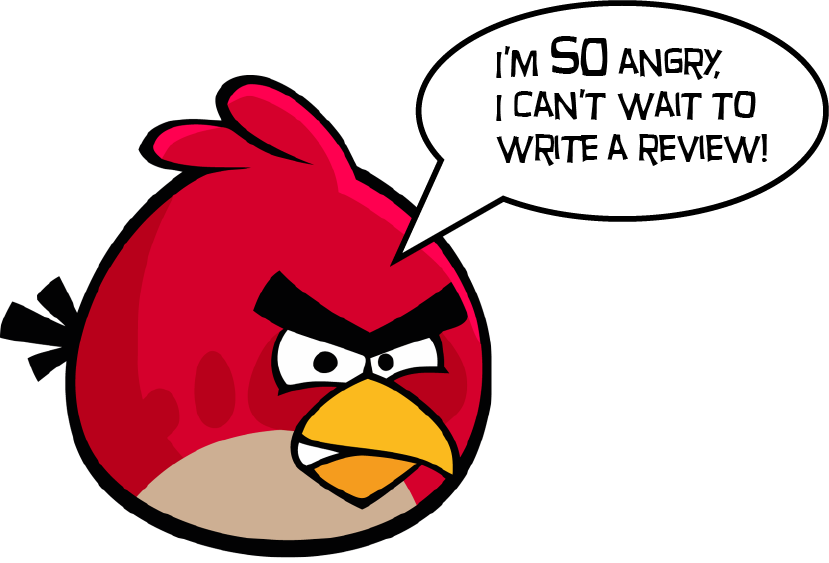
Or, can it?
According to one report, not all customers share their negative experience with companies as 96% of unhappy customers don’t complain and 91% of those simply leave and never come back. But for that 4% of unhappy customers that do complain, it’s a tough pill for businesses to swallow.
However, many dissatisfied customers are ready to continue buying from you if you know how to handle customer complaints effectively. Research shows that 67% of unhappy clients return if their issue was resolved quickly. Hence, if you can handle a customer complaint quickly and in the right way, you will retain a client, and word about the incident won’t spread too wide.
At the same time, more than one-third of consumers only need up to three reviews before they make the decision to buy. Provided you have a reputation management strategy, bad reviews are not that bad for you.
We’re making customer complaints a little less intimidating by sharing seven steps for how to handle customer complaints effectively:
- Take in their problem
- Acknowledge the problem
- Offer a solution
- Thank the customer
- Record the complaint and track trends
- Create a complaint plan
- Share the resolution
Let’s dive into the details!
Step 1: Identify the root cause of the problem
A complaint is not only a disappointing thing but also a source of insights into how you can improve your product, service, or delivery process. Don’t submit to the primary instinct to panic or confront the angry client. Instead, use the Socratic questioning technique to get to the heart of the problem.
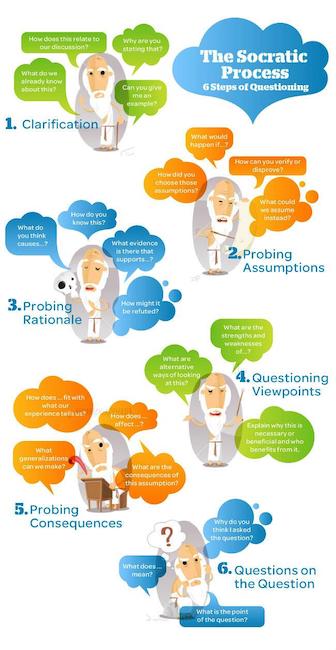
First, clarify the issue. Ask questions like:
- What do you mean by…?
- Could you put it another way?
- Could you give an example?
Make sure you understand the issue and why it is important. Assume the reasons and solutions. Ask as many questions as you need until you feel you don’t need any more information to act on the problem.
You may want to keep a record of the conversation in case you realize you can’t solve the issue and will have to forward the complaint to the right person. As you are about to do this, simply say: “I’m going to connect you with Jim, he will sort it out for you in no time.”
Step 2: Acknowledge the problem
According to Andy Beal, 96% of unhappy customers won’t complain but will simply switch to a competitor. So, if someone took the time to contact you, that alone is valuable.
Express your understanding of the customer’s feelings. You may not agree with them, and that’s where it gets tricky–especially if the complaint is about something in which you’ve invested a lot. But remember that the annoyance is not personal. The customer is not upset about you but about the situation, so distance yourself.
A simple “apologies for the inconvenience” is usually appreciated when responding to customer complaints. There may be times when you can offer a reason an issue happened, but many times it’s best to focus on the resolution rather than the cause of the complaint.

It can be useful to create a knowledge base that stores all the information about the processes behind manufacturing, marketing, shipping, and services. Here, your team can immediately look up data and assume what they should say to the customer.
Step 3: Offer a solution
As you figured out the root cause of the customer’s issue, helped them share their concerns, and found a solution, present them with options to settle the complaint. It’s important to offer more than one solution as the customer may seek something different from you. Reach an agreement on what will work best to fix the consequences of the mistake.
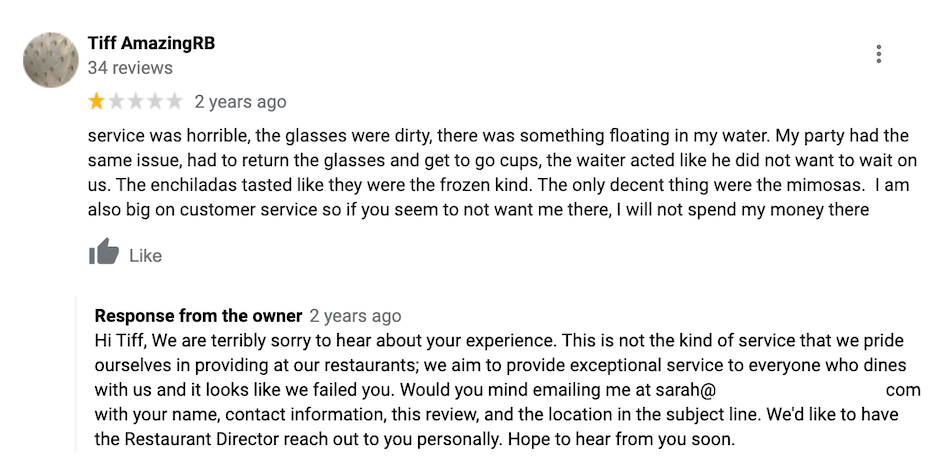
This business asked the customer to reach out so they could have the restaurant director contact them to offer a solution.
After the action has been taken, verify that the solution actually solved the problem. You might not be able to personally monitor how the issue is being addressed. If that’s the case, ask the customer to let you know if you can help them with something else.
Otherwise, you can reassure the customer that the proposed method will work as expected with a clear conscience. You’ll personally see that everything is done properly this time.
Sometimes it may be worth contacting the customer a few days after the problem has been solved to see if they received the expected result. Consider monitoring any feedback that your company gets as negative comments may be a sign something is still wrong. Remember, many customers don’t get to reach out to customer support to complain. But they may leave a comment on social media.
Related: Get tips to improve your customer communications.
Step 4: Thank the customer
Of course you didn’t enjoy that complaint. But without it, you might not have known about opportunities to improve your business. Moreover, the fact that someone contacted you to seek a solution means you still have their trust.
Apologize for upsetting your customer, and thank them for giving you genuine customer feedback. By doing this, they gave you the chance to improve your business and keep them as a loyal client. Let them know that their request will be used to alleviate customer pain points and improve customer service in the future.
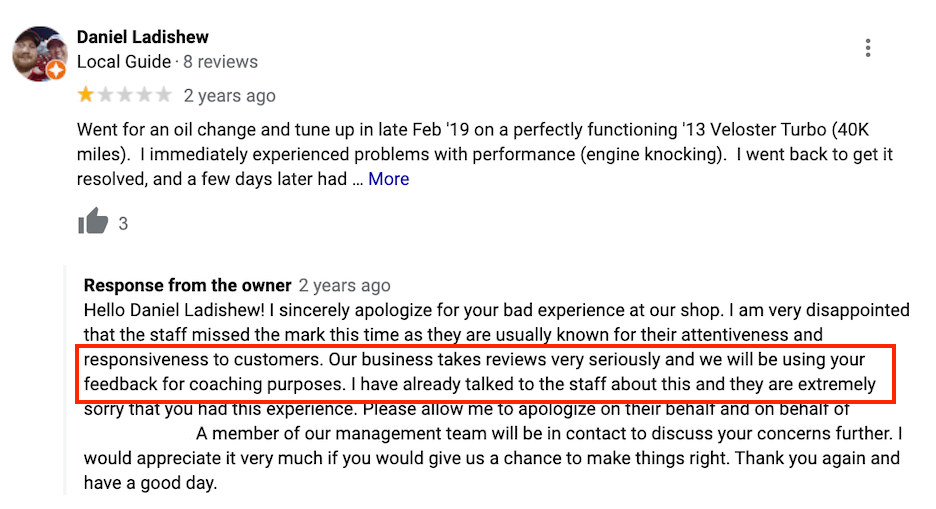
This business let the customer know they would be using this complaint for staff coaching.
Step 5: Keep the record and track trends
You may get a complaint on something that has never been an issue and probably won’t in the future. But if something has been brought up multiple times, this is just the beginning.
You need to keep track of high-volume complaints. Have all incoming complaints documented so you can identify trends and forecast possible issues to fix them before someone notices. For example, your product could glitch—and by having the issue described by many people, you can find and fix it quickly.
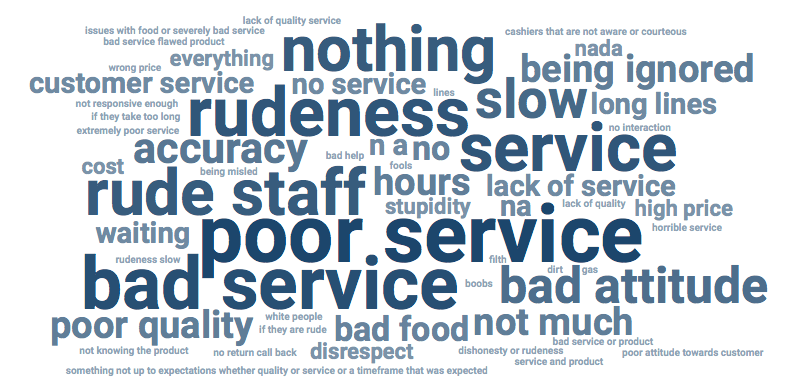
This word cloud shows common complaints collected by this business.
It’s also useful to log in how a certain issue was solved, for future reference.
As mentioned earlier, many customers won’t complain directly to you, so the good idea is to get proactive and monitor negative comments on the web. You can start by checking reviews on your company blog and social media pages. For more advanced social listening, search for brand name mentions on Twitter and find out whether your business is listed in any complaint directories or forums.
When you see a negative review, respond to it. According to SproutSocial, 65% of customers feel connected to brands that are active on social media. Customers tend to associate online activity as a sign that the brand is caring about its clients.
Step 6: Create a complaint plan
Having a plan can help you focus on the issue and keep emotions under control. Use the history of complaints to see what can probably go wrong and decide how you can handle the complaint before it comes up. Then create a policy to align your customer support team’s response and actions.
The best practices for complaint policies are to:
- Document and report any occurring problem to the appropriate person;
- Assign a person to monitor the process of resolving complaints;
- Determine the maximum amount of time during which a complaint must be addressed;
- Define behaviors and actions your team must take to provide the best customer experience;
- Keep the case open until the root problem is identified and resolved.
With written guidelines, your customer service representative will react promptly, efficiently, and politely in a critical situation. Thus, you increase the chances of retaining the customer and not losing potential clients due to bad word of mouth.
Step 7: Share the resolution
What if there were just too many angry comments well before you even realized your business had a problem?
Your first thought might be to clear out all the mess and pretend as if nothing has happened. And that’s what Nielsen Norman, a UX consulting company, did when their post got criticized. The company deleted the video, wiped out all the mentions of it, and redirected the links.
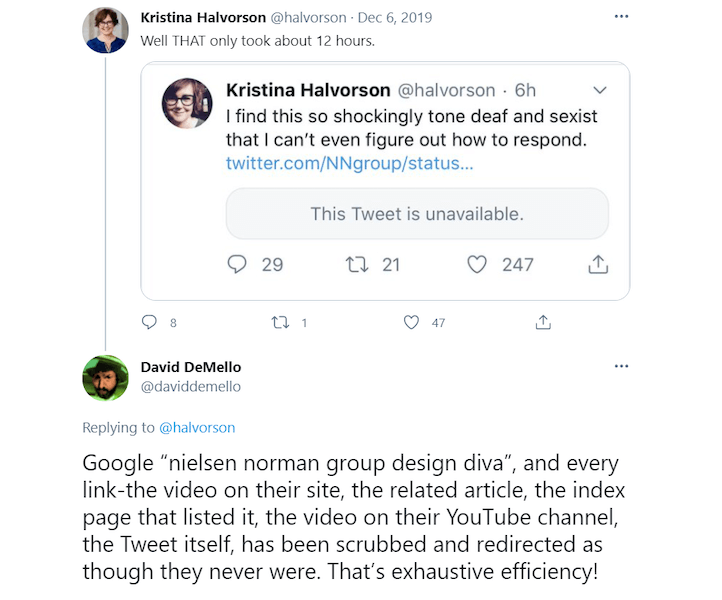
And yet, their radio silence upset their followers, who waited for the formal apology.
So, instead of trying to reverse the time, consider publicly admitting your mistake. Explain the causes of the mistake and what actions your team has taken to resolve it. Depending on the problem nature and your industry, you can share a raw video or go creative.
An example of a humorous reaction that worked out well is KFC. When they experienced a sudden chicken shortage and had to close their restaurants, it caused confusion and rage in their customers. The company launched an apologetic campaign featuring a reworked logo “FCK” paired with an explanation of what happened and a promise that it won’t happen again.

Handle customer complaints like a champ
Complaints happen. At the end of the day, it’s impossible to keep everyone happy. Yet, if you handle the complaints with honesty, people will appreciate that. Always bear in mind that the heart of your business operations are people, and it’s not a problem to be resolved but a person to be helped.
Done in a professional and warm manner, customer complaints handling can give you valuable insights regarding your product or service. And, by handling customer complaints effectively, you just might turn an unhappy customer into a happy customer!
About the Author
Julia Serdiuk is an outreach specialist at HelpCrunch, an innovative platform to build relationships with customers. Being a seasoned traveler and yoga enthusiast, she appreciates life and believes in the cloudless future of our planet.






